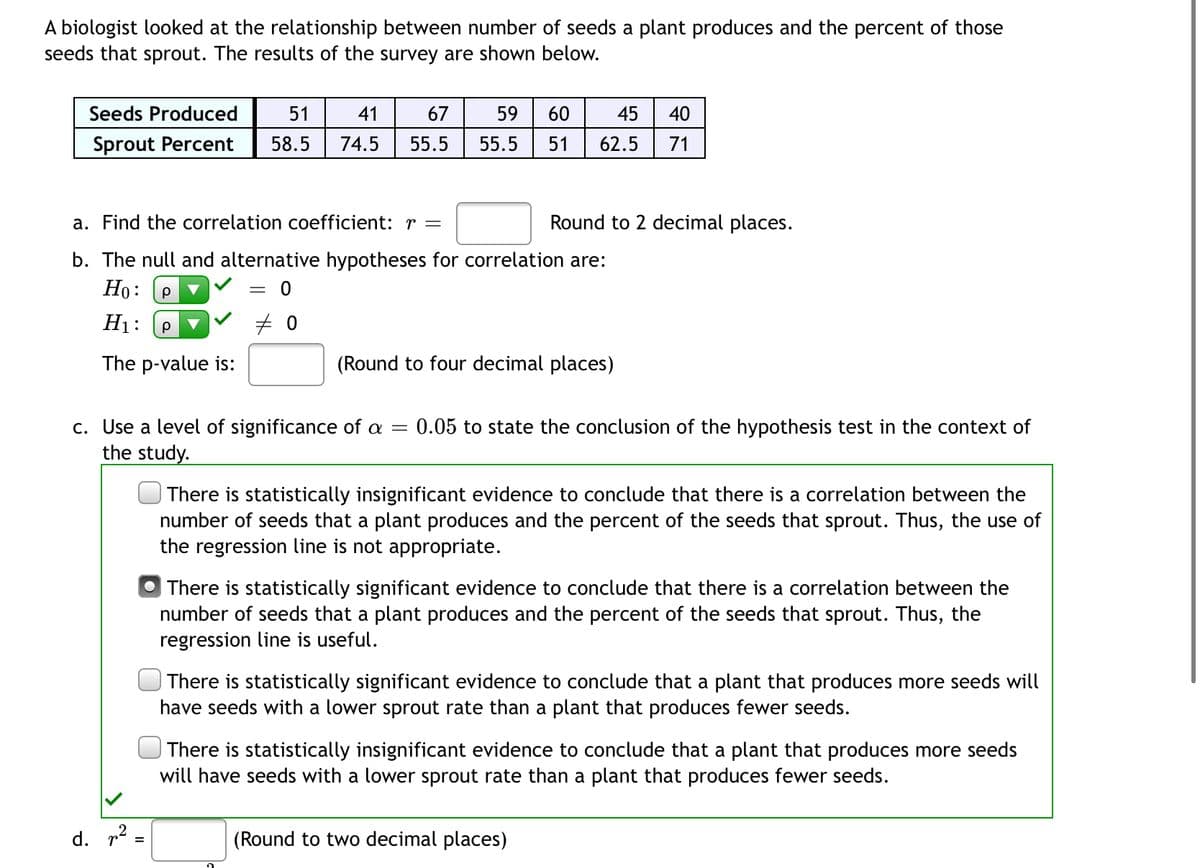A biologist looked at the relationship between number of seeds a plant produces and the percent of those seeds that sprout. The results of the survey are shown below. 51 41 59 60 45 40 Seeds Produced 67 Sprout Percent 58.5 74.5 55.5 55.5 51 62.5 71 a. Find the correlation coefficient: r = Round to 2 decimal places. b. The null and alternative hypotheses for correlation are: Ho: р 0 H₁: P ▼ #0 The p-value is: (Round to four decimal places) c. Use a level of significance of a = 0.05 to state the conclusion of the hypothesis test in the context of the study. There is statistically insignificant evidence to conclude that there is a correlation between the number of seeds that a plant produces and the percent of the seeds that sprout. Thus, the use of the regression line is not appropriate. There is statistically significant evidence to conclude that there is a correlation between the number of seeds that a plant produces and the percent of the seeds that sprout. Thus, the regression line is useful. There is statistically significant evidence to conclude that a plant that produces more seeds will have seeds with a lower sprout rate than a plant that produces fewer seeds. There is statistically insignificant evidence to conclude that a plant that produces more seeds will have seeds with a lower sprout rate than a plant that produces fewer seeds. (Round to two decimal places) d.
A biologist looked at the relationship between number of seeds a plant produces and the percent of those seeds that sprout. The results of the survey are shown below. 51 41 59 60 45 40 Seeds Produced 67 Sprout Percent 58.5 74.5 55.5 55.5 51 62.5 71 a. Find the correlation coefficient: r = Round to 2 decimal places. b. The null and alternative hypotheses for correlation are: Ho: р 0 H₁: P ▼ #0 The p-value is: (Round to four decimal places) c. Use a level of significance of a = 0.05 to state the conclusion of the hypothesis test in the context of the study. There is statistically insignificant evidence to conclude that there is a correlation between the number of seeds that a plant produces and the percent of the seeds that sprout. Thus, the use of the regression line is not appropriate. There is statistically significant evidence to conclude that there is a correlation between the number of seeds that a plant produces and the percent of the seeds that sprout. Thus, the regression line is useful. There is statistically significant evidence to conclude that a plant that produces more seeds will have seeds with a lower sprout rate than a plant that produces fewer seeds. There is statistically insignificant evidence to conclude that a plant that produces more seeds will have seeds with a lower sprout rate than a plant that produces fewer seeds. (Round to two decimal places) d.
Glencoe Algebra 1, Student Edition, 9780079039897, 0079039898, 2018
18th Edition
ISBN:9780079039897
Author:Carter
Publisher:Carter
Chapter4: Equations Of Linear Functions
Section4.5: Correlation And Causation
Problem 11PPS
Related questions
Question
Need A B D

Transcribed Image Text:A biologist looked at the relationship between number of seeds a plant produces and the percent of those
seeds that sprout. The results of the survey are shown below.
45 40
Seeds Produced 51 41 67 59 60
Sprout Percent 58.5 74.5 55.5 55.5
51 62.5 71
a. Find the correlation coefficient: r =
Round to 2 decimal places.
b. The null and alternative hypotheses for correlation are:
Ho: P
= 0
H₁: Р
#0
The p-value is:
(Round to four decimal places)
c. Use a level of significance of a = 0.05 to state the conclusion of the hypothesis test in the context of
the study.
There is statistically insignificant evidence to conclude that there is a correlation between the
number of seeds that a plant produces and the percent of the seeds that sprout. Thus, the use of
the regression line is not appropriate.
There is statistically significant evidence to conclude that there is a correlation between the
number of seeds that a plant produces and the percent of the seeds that sprout. Thus, the
regression line is useful.
There is statistically significant evidence to conclude that a plant that produces more seeds will
have seeds with a lower sprout rate than a plant that produces fewer seeds.
There is statistically insignificant evidence to conclude that a plant that produces more seeds
will have seeds with a lower sprout rate than a plant that produces fewer seeds.
(Round to two decimal places)
d. ² =
Expert Solution
This question has been solved!
Explore an expertly crafted, step-by-step solution for a thorough understanding of key concepts.
Step by step
Solved in 3 steps with 1 images

Recommended textbooks for you

Glencoe Algebra 1, Student Edition, 9780079039897…
Algebra
ISBN:
9780079039897
Author:
Carter
Publisher:
McGraw Hill

Glencoe Algebra 1, Student Edition, 9780079039897…
Algebra
ISBN:
9780079039897
Author:
Carter
Publisher:
McGraw Hill